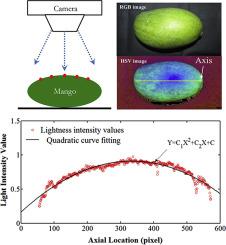当前位置:
X-MOL 学术
›
Biosyst. Eng.
›
论文详情
Our official English website, www.x-mol.net, welcomes your
feedback! (Note: you will need to create a separate account there.)
Vision based volume estimation method for automatic mango grading system
Biosystems Engineering ( IF 4.4 ) Pub Date : 2020-10-01 , DOI: 10.1016/j.biosystemseng.2020.08.021 TheOo Mon , Nay ZarAung
Biosystems Engineering ( IF 4.4 ) Pub Date : 2020-10-01 , DOI: 10.1016/j.biosystemseng.2020.08.021 TheOo Mon , Nay ZarAung

|
In horticulture, measuring, sorting by shape, and determining the size and volume of fruits are all essential processes for meeting market quality standards and increasing market value. Fruit sorting and grading processes are very laborious and time-consuming task but machine vision-based fruit grading systems have the potential to replace human labour. However, a great challenge in vision-based fruit grading system is the recognition of different features such as shape, size, skin flaw and sometimes even three-dimensional (3D) shape. In this study, a simple and efficient image processing algorithm is proposed for estimating volume and 3D shape of mango fruit. The width and length of mango fruit are obtained from two-dimensional (2D) colour image. Then, fruit thickness is estimated based on light intensity distribution in 2D (top view) of mango fruit and maximum width–thickness correlation. The 3D shape of the mango fruit is then reconstructed. The accuracy of proposed method was compare with two existing volume prediction methods. Estimated volumes were compared with measured measurements using water-displacement method and the reconstructed 3D shapes were compared with measured structures of mango fruits. For a total of 150 mango samples, the results show that the proposed method gave an accuracy of 96.8% whilst the two other methods gave 91.7% and 91.5% respectively. The reconstructed mango shapes were therefore in close agreement with measured shapes.
中文翻译:

基于视觉的芒果自动分级系统体积估计方法
在园艺中,测量、按形状分类以及确定水果的大小和体积都是满足市场质量标准和提高市场价值的重要过程。水果分类和分级过程是一项非常费力且耗时的任务,但基于机器视觉的水果分级系统有可能取代人工。然而,基于视觉的水果分级系统的一个巨大挑战是识别不同的特征,如形状、大小、皮肤缺陷,有时甚至是三维 (3D) 形状。在这项研究中,提出了一种简单有效的图像处理算法来估计芒果果实的体积和 3D 形状。芒果果实的宽度和长度是从二维 (2D) 彩色图像中获得的。然后,果实厚度是根据芒果果实的 2D(顶视图)中的光强分布和最大宽度-厚度相关性估算的。然后重建芒果果实的 3D 形状。将所提出方法的准确性与两种现有的体积预测方法进行了比较。将估计体积与使用水置换法的测量值进行比较,并将重建的 3D 形状与芒果果实的测量结构进行比较。对于总共 150 个芒果样本,结果表明,所提出的方法的准确率为 96.8%,而其他两种方法的准确率分别为 91.7% 和 91.5%。因此,重建的芒果形状与测量的形状非常一致。将所提出方法的准确性与两种现有的体积预测方法进行了比较。将估计体积与使用水置换法的测量值进行比较,并将重建的 3D 形状与芒果果实的测量结构进行比较。对于总共 150 个芒果样本,结果表明,所提出的方法的准确率为 96.8%,而其他两种方法的准确率分别为 91.7% 和 91.5%。因此,重建的芒果形状与测量的形状非常一致。将所提出方法的准确性与两种现有的体积预测方法进行了比较。将估计体积与使用水置换法的测量值进行比较,并将重建的 3D 形状与芒果果实的测量结构进行比较。对于总共 150 个芒果样本,结果表明,所提出的方法的准确率为 96.8%,而其他两种方法的准确率分别为 91.7% 和 91.5%。因此,重建的芒果形状与测量的形状非常一致。8%,而其他两种方法分别为 91.7% 和 91.5%。因此,重建的芒果形状与测量的形状非常一致。8%,而其他两种方法分别为 91.7% 和 91.5%。因此,重建的芒果形状与测量的形状非常一致。
更新日期:2020-10-01
中文翻译:

基于视觉的芒果自动分级系统体积估计方法
在园艺中,测量、按形状分类以及确定水果的大小和体积都是满足市场质量标准和提高市场价值的重要过程。水果分类和分级过程是一项非常费力且耗时的任务,但基于机器视觉的水果分级系统有可能取代人工。然而,基于视觉的水果分级系统的一个巨大挑战是识别不同的特征,如形状、大小、皮肤缺陷,有时甚至是三维 (3D) 形状。在这项研究中,提出了一种简单有效的图像处理算法来估计芒果果实的体积和 3D 形状。芒果果实的宽度和长度是从二维 (2D) 彩色图像中获得的。然后,果实厚度是根据芒果果实的 2D(顶视图)中的光强分布和最大宽度-厚度相关性估算的。然后重建芒果果实的 3D 形状。将所提出方法的准确性与两种现有的体积预测方法进行了比较。将估计体积与使用水置换法的测量值进行比较,并将重建的 3D 形状与芒果果实的测量结构进行比较。对于总共 150 个芒果样本,结果表明,所提出的方法的准确率为 96.8%,而其他两种方法的准确率分别为 91.7% 和 91.5%。因此,重建的芒果形状与测量的形状非常一致。将所提出方法的准确性与两种现有的体积预测方法进行了比较。将估计体积与使用水置换法的测量值进行比较,并将重建的 3D 形状与芒果果实的测量结构进行比较。对于总共 150 个芒果样本,结果表明,所提出的方法的准确率为 96.8%,而其他两种方法的准确率分别为 91.7% 和 91.5%。因此,重建的芒果形状与测量的形状非常一致。将所提出方法的准确性与两种现有的体积预测方法进行了比较。将估计体积与使用水置换法的测量值进行比较,并将重建的 3D 形状与芒果果实的测量结构进行比较。对于总共 150 个芒果样本,结果表明,所提出的方法的准确率为 96.8%,而其他两种方法的准确率分别为 91.7% 和 91.5%。因此,重建的芒果形状与测量的形状非常一致。8%,而其他两种方法分别为 91.7% 和 91.5%。因此,重建的芒果形状与测量的形状非常一致。8%,而其他两种方法分别为 91.7% 和 91.5%。因此,重建的芒果形状与测量的形状非常一致。











































 京公网安备 11010802027423号
京公网安备 11010802027423号